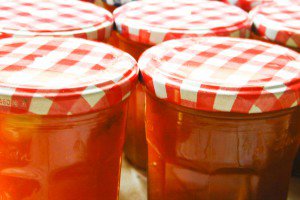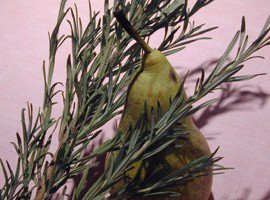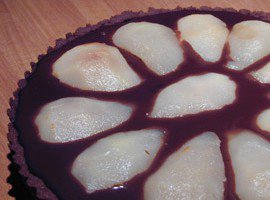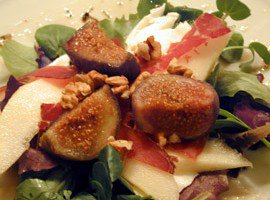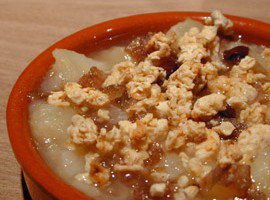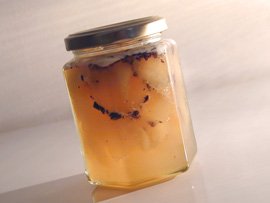
[Pear Jam with Cacao Nibs]
Just recently, I had a sudden urge to make jam — it may have to do with my own dwindling supply of the homemade stuff, or the sudden realization that spring strawberries would not last forever (as opposed to strawberry fields). In any case, when I went to the market a couple of weeks ago, it was with the firm intention to purchase fruit and make jam.
The strawberries were still way too pricy (at 4€ for a half-pound basket, they would make some luxurious jam indeed) but the guy at the produce stall said he had a crate of very ripe Conférence pears — he used the expression poires blettes, which I’ve always found ugly and off-putting, but I knew what he meant — that could be used for jam. Insert happy inner voice here (“Oh wow! Pear jam! I have never made pear jam! Pear jam sounds really good!”), and I got two kilos for just a little over 3€.
As I set out to peel and core them, I was a little anxious to see just how ripe and/or bruised they were, but they turned out to be just fine — and in fact very sweet and juicy, as indicated by the amount I surreptitiously ate while prepping them.
To make the jam, I loosely followed the instructions Christine Ferber gives in her excellent Mes Confitures book. I didn’t have any of the apple jelly she calls for however, so my jam will probably not set very well — pears are naturally low in pectin — but I don’t mind: runny jam makes for a fabulous coulis or yogurt topping.
Since pears and chocolate are a notoriously happy couple, I decided to experiment with stirring some cacao nibs into the jam after it was cooked. Pear and pistachio sounded good too, so I made a few jars with shelled pistachios as well, and left a few jars plain, for simplicity’s sake. The cacao nibs and pistachios had a tendency to bob to the surface, but I am hoping that they will still infuse the jam with flavor and add textural variety.
No tasting notes as of yet — it is best to give the jars a few months in the cool and quiet darkness of my kitchen cabinets, before I open them and report back!
(The amount of pears that I had yielded eight jars of assorted shapes and sizes, so I scaled things down a bit in the recipe below.)
Confiture de Poire aux Eclats de Fève de Cacao
– 1.25 kg (2.5 lbs) ripe pears — 1 kg (2 lbs) once peeled and cored
– 1 kg (2 lbs) sugar (if it is available to you, use pectin-enriched sugar, a sugar that’s especially made for jams: in France it is labelled as sucre spécial confiture)
– the juice of one lemon
– 1/4 C cacao nibs
(Yields four to five jars.)
Wash, peel and core the pears. Cut them in one-inch chunks. Weigh the amount of pear chunks that you get (about 1 kg or 2 lbs), and combine them in a large pan with the same weight of sugar and the lemon juice. Cover and bring to a simmer over medium heat. Transfer into a large dish (glass, ceramic or eathenware) and cover the surface with a sheet of parchment paper. Let cool to room temperature on the counter, then keep in the fridge overnight.
The next day, put a saucer in the freezer. Wash the glass jars and their lids carefully, then soak them in boiling water for 10 minutes, and set them out to dry upside down on a clean kitchen towel.
Return the fruit mixture into the pan, bring to a simmer and cook for five minutes, stirring gently with a wooden spoon. Remove from heat and spoon out the foam if desired (this will make for a clearer jam, but I personally don’t do this — in any case don’t discard the foam, use it to sweeten plain yogurt or serve it with scones). Bring to a simmer again. Take the saucer out of the freezer, pour a drop of jam on it and tilt the saucer: if the drop stays put, the jam is ready. If it is still liquid, simmer for another minute or two.
Pour the jam carefully into the jars so they are almost full, divide the cacao nibs evenly among them, stir carefully with a spoon to combine, pour in more jam so the jar is completely full, wipe carefully if there was any spillage and close the lids tightly. Let cool to room temperature upside-down on the counter, then store in a cool and dark place for a few months.
Variations: I also made a few plain jars and a few with shelled unsalted pistachios.
Important disclaimer! This jarring method (boiling the jars then closing them tightly and letting them cool upside down) is one that’s been commonly practiced in France for generations and generations. However, using a sterilizing machine and rubber-lidded jars is the only way to be absolutely safe. For more information on home-canning, click here.



